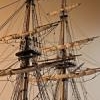-
Posts
1,231 -
Joined
-
Last visited
Content Type
Profiles
Forums
Gallery
Events
Everything posted by KenW
-
All I can say is, "WOW"! Your work is always professional quality. A pleasure to follow along. Cheers.
-
Thanks Mike. I showed it with the sweeps last night. Once it's in it's case, the sweeps will be tied into the irons. Cheers.
- 238 replies
-
- sloop
- providence
-
(and 1 more)
Tagged with:
-
Last Night I presented the completed model of the Providence to my ship model club. The updates I made since my last posting were to add the ensign on a staff, and to rig the ship's boat from davits at the stern. The ensign is a variation of the Grand Union Flag that was in use by both the army and navy from 1775 to 1777. I chose the variant with red, white and blue stripes as seen on the 1777 Holman painting (see my first post). The ship's boat rigging was simple; and I am hanging the boat so it will be in the water. There is a knotted line for the crew to access the boat without the need to raise it. Thanks to all who followed this build and I hope to have another build log started soon.
- 238 replies
-
- sloop
- providence
-
(and 1 more)
Tagged with:
-
I completed the installation of the anchors. That included making and rigging the buoys. I based my anchor design on, “Historic Ship Models”, by Wolfram zu Mondfeld. The buoys are modeled after the Cheerful blog of Chuck Passaro. The buoy line is long enough to reach seventeen fathoms; the anchor cable is attached to the anchor using a fisherman’s bend.
- 238 replies
-
- sloop
- providence
-
(and 1 more)
Tagged with:
-
Keep the long explanations coming. At some point, I'll look back and remember and praise your thoroughness. Thanks.
-
Thanks for the kind words Tom and Gary. Cheers.
- 238 replies
-
- sloop
- providence
-
(and 1 more)
Tagged with:
-
The latest update is the carved anchors. I carved them from a 3/32 sheet of boxwood. I once tried to carve anchors out of basswood but always got the inevitable split along the grain. Anyway, an attached photo shows the steps in the process. The anchor on the left is cut from a jeweler’s saw. I use files to reduce the anchor so it looks like the middle one. And sand/file some more and add the carved ‘blades’. The second photo has the completed anchors. I still have to make buoys and the lines for them. And, of course, attach them to the boat along with the anchor cables. So much to do.
- 238 replies
-
- sloop
- providence
-
(and 1 more)
Tagged with:
-
I have made the rope coils and glued down all the lines to their belaying pins. The shrouds and back stays are also tied down. I still don’t like the coils, but these are the best I’ve done. I’ll try some new ideas for my next model. I also redid the photo of the boat with the sweeps out. I realized that the jolly boat also has oars. So I put those oars on the small boat and edited the last post.
- 238 replies
-
- sloop
- providence
-
(and 1 more)
Tagged with:
-
Thanks Lou and Brian. I intend to stow the oars, but not tie them down with glue so that they could be released. The flag will be on a pole that would be taken down when the boat is under sail. There will be a eye bolt and block to raise the flag on the gaff. Cheers.
- 238 replies
-
- sloop
- providence
-
(and 1 more)
Tagged with:
-
I’ve been remiss with my posting, but my current status has the rigging, for the most part, done. I still have a few lines to do; and, of course, I need to trim all the excess and add rope coils. I also have to make adjustments so the yards are positioned correctly. That will be done as I tie the lines down permanently. The whole mast structure is surprisingly tall. I’m told that is common with American boats. I also drilled the sweep holes into the hull. I was very reluctant to do that, but it turned out O.K. The oars even fit through the holes (oar blades as well). I do need to get a good camera. My iPhone(8) doesn’t take photos that well.
- 238 replies
-
- sloop
- providence
-
(and 1 more)
Tagged with:
-
I made some changes to the rigging of the traveler to reflect my research. I just added a long block which enables the line to lie further away from the jib down haul and the bow sprint cap.
- 238 replies
-
- sloop
- providence
-
(and 1 more)
Tagged with:
-
I finished furling the jib. It looks OK, but I’m not yet sure how I will belay the staysail and jib sheets. I added (not glued) two timber heads, but I may not use both. I’m still thinking and trying different solutions. There aren’t many books on fore and aft boats.
- 238 replies
-
- sloop
- providence
-
(and 1 more)
Tagged with:
-
The ‘fore’ staysail has been furled. I had to try three different positions before I found one that I liked. Again the lines - halyard, downlauler, and sheets - are not belayed to their final location in the forecastle.
- 238 replies
-
- sloop
- providence
-
(and 1 more)
Tagged with:
-
Thanks Mike. The stay line is home made. I used the Syren rope walk and recommended formulas. In the case of the fore stay it was made from Gutterman Mara 70, 4 strands. Cheers.
- 238 replies
-
- sloop
- providence
-
(and 1 more)
Tagged with:
-
Next up is the foremast staysail. I’m going to attempt to use hanks rather than just a metal ring. The hanks will be of metal, however, made to look like a wooden hank. I’m using 28 gauge black wire. First, I made the hanks and tied them with a very thin thread using a clove hitch. The hanks were placed over the fore stay, and each hank was tied using a hole made using a drill where the “cloths” joined. Add a little diluted white glue, trim the thread once the glue dries and cut off the exposed metal ends. Once all the hanks are done the sail looks ready to be furled. However, that will have to wait until after after I make another Medway stove.
- 238 replies
-
- sloop
- providence
-
(and 1 more)
Tagged with:
-
Thanks Gary. Nice to meet you at the Northeast Conference. Cheers.
- 238 replies
-
- sloop
- providence
-
(and 1 more)
Tagged with:
-
I’m fully into the process of rigging the vessel. I’ve added the boom topping lift, the fore stay, the fore back stay and the jib stay. All of these lines were made using the rope I made using the Syren rope walk. Next I’m going to tie the rat lines; but I’m leaving the shrouds still attached with the wires. Just in case I need to move them out of the way as rigging continues. Also, the lines tied to the belaying pins are not glued or trimmed.
- 238 replies
-
- sloop
- providence
-
(and 1 more)
Tagged with:
-
I agree with Glen. I've had no problem with the standard WOP. I just wanted to warn people that there are two versions. I would recommend avoiding the water based. And make sure you sand the area smooth - use 400 grit or finer. Cheers.
- 1,784 replies
-
- winchelsea
- Syren Ship Model Company
-
(and 1 more)
Tagged with:
-
I would advise against Acrylic Wipe-on-Poly. I got that version by mistake awhile back. Cheers.
- 1,784 replies
-
- winchelsea
- Syren Ship Model Company
-
(and 1 more)
Tagged with:
-
The number of guns on the Providence changed during its lifetime. When it was converted from a merchant, it "took" 6 guns from British stores. So, at first, it had 6 guns. By the time command was given to JP Jones in Jan., 1776, she had "acquired" 10 guns. When she was destroyed at Penobscot, she reportedly had 14. I initially had the projections from the quarterdeck, but didn't like the look of it. Other models done in the 1930s didn't have that either. My choice. My model will have a ships boat hanging from the stern. Thanks for your comments.
- 238 replies
-
- sloop
- providence
-
(and 1 more)
Tagged with:
About us
Modelshipworld - Advancing Ship Modeling through Research
SSL Secured
Your security is important for us so this Website is SSL-Secured
NRG Mailing Address
Nautical Research Guild
237 South Lincoln Street
Westmont IL, 60559-1917
Model Ship World ® and the MSW logo are Registered Trademarks, and belong to the Nautical Research Guild (United States Patent and Trademark Office: No. 6,929,264 & No. 6,929,274, registered Dec. 20, 2022)
Helpful Links
About the NRG
If you enjoy building ship models that are historically accurate as well as beautiful, then The Nautical Research Guild (NRG) is just right for you.
The Guild is a non-profit educational organization whose mission is to “Advance Ship Modeling Through Research”. We provide support to our members in their efforts to raise the quality of their model ships.
The Nautical Research Guild has published our world-renowned quarterly magazine, The Nautical Research Journal, since 1955. The pages of the Journal are full of articles by accomplished ship modelers who show you how they create those exquisite details on their models, and by maritime historians who show you the correct details to build. The Journal is available in both print and digital editions. Go to the NRG web site (www.thenrg.org) to download a complimentary digital copy of the Journal. The NRG also publishes plan sets, books and compilations of back issues of the Journal and the former Ships in Scale and Model Ship Builder magazines.






